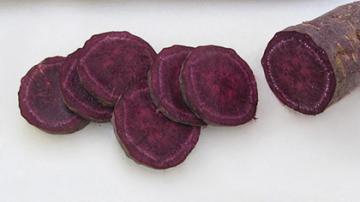Purple Sweetpotatoes for Thanksgiving and More

Purple sweetpotatoes are high in beneficial phytochemical nutrients called anthocyanins. ARS and North Carolina State University researchers found a way to preserve anthocyanin content during processing into juice or natural colorants. (Photo by Van-Den Truong, D3099-1)
Bright-orange sweetpotatoes are a staple of many American Thanksgiving dinners and are often prepared with a traditional family recipe. But this year, why not start a new tradition with purple-fleshed sweetpotatoes?
Both colors of sweetpotato are high in dietary fiber, vitamins, and minerals, but the purple varieties are also rich in health-beneficial antioxidants called anthocyanins and phenolic acids. Anthocyanins are plant pigments that make blueberries blue and cherries cherry-red, and the antioxidant activities in purple sweetpotatoes can be at similar levels to these antioxidant-rich fruits. Various studies have indicated that anthocyanins and phenolics from purple‐fleshed sweetpotatoes may have potential health benefits.
A team of scientists from the Agricultural Research Service’s Food Science and Market Quality and Handling Research Unit in Raleigh, NC, collaborated with researchers at North Carolina State University to find ways to preserve purple-fleshed sweetpotatoes’ anthocyanin levels during processing into products like juice or natural colorants. Typically, heat is used during processing, but heat changes the flavor and prevents isolation and use of sweetpotato starch and fiber. But if heat is not used, then the flesh quickly browns due to the same enzymes that turn sliced apples brown.
The scientists wanted to figure out a heat-free way to extract the juice and pigments directly from the raw purple sweetpotato. After those are extracted, what’s left is raw starch and fiber (pomace), each with its own uses and benefits.
The team successfully used water containing a small amount of citric acid, a substance naturally present in citrus fruits, to inactivate the browning enzymes and preserve an appealing reddish-purple color in the fresh juice and pomace. Preserving the high anthocyanin content makes these products desirable as functional ingredients in beverages and other food products. This research can pave the way for sweetpotato processors to produce new, value-added products. The team published the study in the Journal of Food Science in 2019.—By Sue Kendall, ARS Office of Communications.
You May Also Like
-
New Variety Will Help Age-Old Crop Prosper Beyond the 21st Century
-
Changing Tastes: Rise and Fall of the Beltsville Small White Turkey

